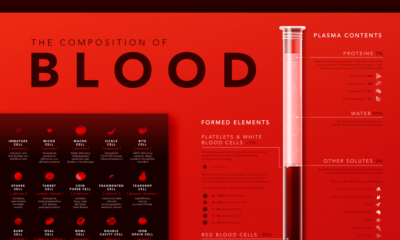Today’s graphic comes from Raconteur and highlights some startling takeaways from the 2019 Philips Global Sleep Survey, answered by over 11,000 adults from 12 countries. Let’s settle in to discover what impacts our sleeping habits, also known as sleep hygiene, and what helps people sleep better and longer.
Why Sleep Is Important
Roughly 62% of adults worldwide feel that they don’t sleep well when they go to bed. Losing just one or two hours of sleep per night can have the same impact on motor and cognitive functions as going without sleep for a full day or two. Experts have long emphasized that developing good sleeping habits can help to maintain our physical, mental, and emotional well-being. Ongoing sleep deprivation can also cause severe, long-term health conditions:
Heart disease and heart failure Weak immune system High blood pressure Kidney disease Depression Diabetes Obesity
Drowsiness has been a significant factor in roughly 100,000 car accidents every year, causing an estimated 1,500 deaths. Sleep deficiency has also been linked to a number of disasters, such as airplane and boat accidents, and even nuclear reactor meltdowns.
The Science of Sleep
The human body follows the circadian rhythm─a 24-hour repeating rhythm that operates as an internal clock. This clock is controlled by two things: external cues such as light and darkness, and internal compounds that trigger and maintain our sleep. These chemicals work together to keep our sleep/wake cycles in harmony.
Adenosine: slowly builds the desire for sleep throughout the day Melatonin: produces drowsy feelings that signal your body is now ready for sleep Cortisol: naturally triggers your body to wake up
While sleep duration can vary greatly around the world, most adults are still not getting enough shut-eye. The average person gets 6.8 hours of sleep on a weeknight, which is significantly lower than the recommended 8 hours. One company in the UK has even developed a real-time map of social media posts from people who say they can’t fall or stay asleep.
What Prevents Better Sleep?
People can suffer from a lack of sleep for many reasons─below are the top six culprits.
Developing Good Sleeping Habits
Sleep is often the first to be neglected with our hectic schedules. Here are a few ways to practice better habits for a good night’s sleep. Routine Wake up and go to bed at the same time each day─even on weekends─to establish a more ingrained rhythm for your body clock and help your brain better prepare for sleep. Exercise Pick a time of day that suits your schedule and energy levels, and be sure to stick with it. Exercise helps to balance melatonin and cortisol levels throughout the day. Light Get outside often during the day and reduce the time spent outside at night. Limit screen time at least 30-60 minutes before sleep. Food and Drink Avoid eating large meals or drinking alcohol or caffeine in the last couple of hours before you go to sleep. Caffeine effects can linger for up to 8 hours, which breaks natural sleep rhythms. Meditation Recent studies have shown that mind-body treatments for insomnia such as yoga, tai chi, and meditation had positive impacts on improving sleep quality. Comfort Set the bed for success—keep your room cool and dark, buy a high-quality mattress and comfortable bed linens and use a white-noise machine to help you fall asleep. Sleep is one of the most important aspects of our health; it’s also one of the easiest to neglect. Don’t put yourself into sleep debt─get enough shut-eye to enjoy those sweet dreams. on Even while political regimes across these countries have changed over time, they’ve largely followed a few different types of governance. Today, every country can ultimately be classified into just nine broad forms of government systems. This map by Truman Du uses information from Wikipedia to map the government systems that rule the world today.
Countries By Type of Government
It’s important to note that this map charts government systems according to each country’s legal framework. Many countries have constitutions stating their de jure or legally recognized system of government, but their de facto or realized form of governance may be quite different. Here is a list of the stated government system of UN member states and observers as of January 2023: Let’s take a closer look at some of these systems.
Monarchies
Brought back into the spotlight after the death of Queen Elizabeth II of England in September 2022, this form of government has a single ruler. They carry titles from king and queen to sultan or emperor, and their government systems can be further divided into three modern types: constitutional, semi-constitutional, and absolute. A constitutional monarchy sees the monarch act as head of state within the parameters of a constitution, giving them little to no real power. For example, King Charles III is the head of 15 Commonwealth nations including Canada and Australia. However, each has their own head of government. On the other hand, a semi-constitutional monarchy lets the monarch or ruling royal family retain substantial political powers, as is the case in Jordan and Morocco. However, their monarchs still rule the country according to a democratic constitution and in concert with other institutions. Finally, an absolute monarchy is most like the monarchies of old, where the ruler has full power over governance, with modern examples including Saudi Arabia and Vatican City.
Republics
Unlike monarchies, the people hold the power in a republic government system, directly electing representatives to form government. Again, there are multiple types of modern republic governments: presidential, semi-presidential, and parliamentary. The presidential republic could be considered a direct progression from monarchies. This system has a strong and independent chief executive with extensive powers when it comes to domestic affairs and foreign policy. An example of this is the United States, where the President is both the head of state and the head of government. In a semi-presidential republic, the president is the head of state and has some executive powers that are independent of the legislature. However, the prime minister (or chancellor or equivalent title) is the head of government, responsible to the legislature along with the cabinet. Russia is a classic example of this type of government. The last type of republic system is parliamentary. In this system, the president is a figurehead, while the head of government holds real power and is validated by and accountable to the parliament. This type of system can be seen in Germany, Italy, and India and is akin to constitutional monarchies. It’s also important to point out that some parliamentary republic systems operate slightly differently. For example in South Africa, the president is both the head of state and government, but is elected directly by the legislature. This leaves them (and their ministries) potentially subject to parliamentary confidence.
One-Party State
Many of the systems above involve multiple political parties vying to rule and govern their respective countries. In a one-party state, also called a single-party state or single-party system, only one political party has the right to form government. All other political parties are either outlawed or only allowed limited participation in elections. In this system, a country’s head of state and head of government can be executive or ceremonial but political power is constitutionally linked to a single political movement. China is the most well-known example of this government system, with the General Secretary of the Communist Party of China ruling as the de facto leader since 1989.
Provisional
The final form of government is a provisional government formed as an interim or transitional government. In this system, an emergency governmental body is created to manage political transitions after the collapse of a government, or when a new state is formed. Often these evolve into fully constitutionalized systems, but sometimes they hold power for longer than expected. Some examples of countries that are considered provisional include Libya, Burkina Faso, and Chad.













